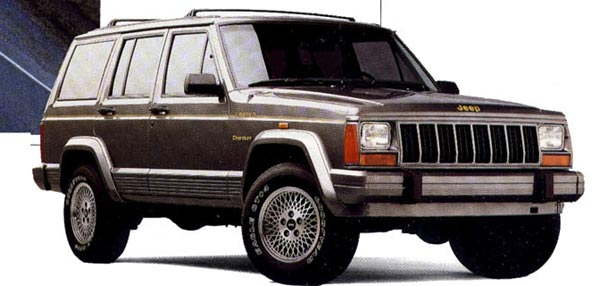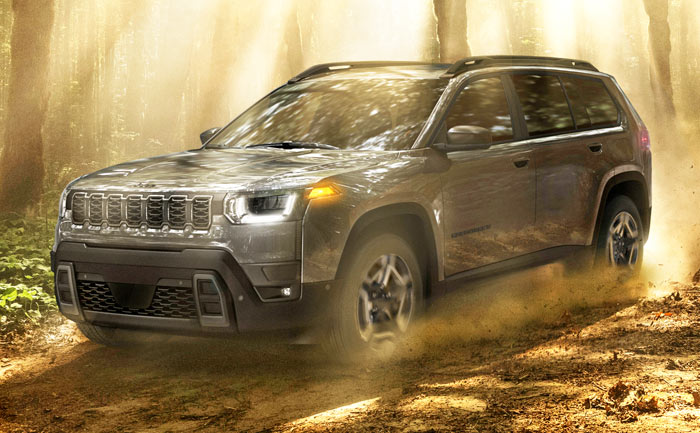
The CVT turns out to be a planetary gear system.
Few remember the original Jeep Cherokee, a cheaper Wagoneer. Its run was almost totally drowned out by the revolutionary Cherokee “XJ,” an incredibly well-designed unibody off-road wagon that could be driven like a station wagon or over the Rubicon Trail; it combined decent economy with high ground clearance and low seating positions. Jeep is playing off memories of the XJ with publicity for the 2026 Cherokee (“KM”), successor to the lambasted KL—which, in Trail Rated form, could still conquer the Rubicon.

The 2026 Jeep Cherokee has nothing in common with the KL. It uses the STLA Large-based Wagoneer S body with a hybrid-electric powertrain, and, sadly, its pointless electric-opener doors. The size and shape and interior are similar to the Wagoneer S, since they share a body (forcing a long hood on the electric Wagoneer S). Buyers can choose between a black interior (shown below in a high trim) and Arctic White, optional on all but the base model. Carpets are made of recycled materials and non-leather materials were used for sustainability.

Prices start at $36,995—about the same as the Grand Cherokee (which has almost nothing else in common)! Each trim level increase adds $3,000—from the base, that’s Laredo, Limited, and Overland, the latter at $45,995. Destination is around $2,000, a higher fee than Toyota charges. We had predicted a price in the low $30,000s, assuming less standard equipment, along with “the usual games with colors other than white (or black) costing $600-$800, an $1,800 destination charge, and so on.” (Destination is $1,995.)
In Canada, the price is $42,390 CAD for the base model; Laredo is $5,000 more. The Limited ($52,390) and Overland will arrive first ($56,390). Canadian figures are in CAD and include destination and fees. All Cherokees will be made at the Toluca, Mexico plant, former home of the PT Cruiser, Neon, and Journey. Entry level trims arrive in 2026.

The price seems high, but every Cherokee is large and loaded with features—with a 12.3 inch high-resolution center screen and 10.25 inch gauge cluster display. The car has wireless phone control (CarPlay/Auto); rain-sensing wipers; active cruise control and lane keeping; and blind spot monitoring with rear cross path detection and intersection collision alerts. Comparing apples to apples, it’s reasonably priced.

The 2026 Jeep Cherokee has no hints of the most popular Cherokee, the XJ. The Trailhawk is still under way and there are no public photos of it, so far. In theory, the promised Trailhawk (name uncertain) could be further off the ground, with skid plates and greater suspension travel, though it won’t come close to the ingenuity of the Cherokee “XJ,” and a Rubicon-capable Cherokee is unlikely. The Trailhawk is likely to come with Active Drive II, a more sophisticated all wheel drive system. The good news for off-road chops is that every Jeep Cherokee has all wheel drive—Jeep Active Drive I. They also have choices of automatic, Sport, Snow, and Sand/Mud driving modes. The rear axle can disconnect when not needed to save fuel, leaving the Cherokee in front wheel drive.

The Cherokee is the longest vehicle to wear that name, and possibly the widest, and could probably be made alongside the Grand Cherokee at Mack Avenue. Yet it doesn’t have particularly good leg room, compared the much shorter XJ and KL Cherokees. Its drag coefficient (cD) of 0.335 is oddly high for 2026, as well; the Cherokee has a CdA of 9.7 square feet.

The hybrid system provides 37 mpg combined (42 city, 33 highway); and the tow rating is up to 3,500 pounds, with the optional towing package (this is down from 4,500 pounds for the 2019 Cherokee V6). Zero to sixty mph comes in 8.3 seconds, which is neither terrible nor terrific, and certainly far from the Wagoneer S. It’s likely the system was tuned for durability and economy, and that power boosts are coming in the future.
Gasoline engine details. The gasoline engine uses high pressure direct injection, and is good for 177 hp and 221 lb-ft of torque—the peak torque good for 2,000 through 3,500 rpm. It runs on the Miller cycle, keeping the intake valves open longer for efficiency, and has a high 11.3:1 compression ratio; a liquid charge air cooler (often mistakenly called an intercooler) reduces intake air temperature. The block and head are made of high pressure die-cast aluminum. The turbocharger runs at up to 38 psi.
Hybrid system details. The liquid-cooled lithium-ion battery can propel the Cherokee at up to 100 km/hour (62 mph) for short distances without the gasoline engine, part of what provides the surprisingly good fuel economy (37 mpg combined). The climate control and engine cooling systems are electrical, not mechanical, to reduce engine load and keep cooling under battery-only driving. There are two motor/generators. On startup, the first one (MG 1) spins the engine to speed, so there is no traditional starter. In EV mode, MG 2 powers the car under light demand. In hybrid mode, MG 1 acts as an alternator and powers the wheels; MG 2 can add power, drawing from either MG 1 or the battery. Regenerative braking and driving in reverse use MG 2. With the engine, the car has 210 hp and 230 lb-ft at peak output. A DC-DC converter provides 12 volts for accessories. The battery itself is a 1-kWh design.
Stellantis is claiming a 30% increase in cargo capacity over the prior Cherokee.
The table is courtesy of suzq044 and allpar. Width is the smallest figure, without mirrors. Numbers have been updated with actual Cherokee figures; the length is a little shorter than the Wagoneer S. The Cherokee KM has a 13.7 gallon tank and 18.5 inch sill height. * indicates 1991 Grand Wagoneer figures; older SJ Cherokee should be similar.
| Cherokee | SJ | XJ | KL | KM |
|---|---|---|---|---|
| Wheelbase | 108.7 | 101.4 | 106.3 | 113.0 |
| Length | 186.4 | 167.5 | 182.0 | 188.1 |
| Width | 74.8 | 67.7 | 73.2 | 74.7 |
| Height | 66.4 | 64.0 | 67.8 | 67.5 |
| Weight | 4,514 | 3,664 | 4,046 | 4,295 |
| Cargo (cf) | 43.1 | 29.7 | 25.8 | 33.6 |
| (Seats folded) | 74.5 | 54.9 | 68 | |
| Legroom | 77.5 | 79.9 | 81.4 | 79.8 |
Note: we corrected the KL cargo figures, which were unaccountably wrong.
Metric: length 4.78m, width 1.90m, height 1.71m, wheelbase 2.87m. Built in Mexico, engine and transmission made in USA.
Key offroad figures are similar to the prior-generation Cherokee KL so far. None come close to the XJ.
| Trailhawk | XJ | KL | KM |
|---|---|---|---|
| Approach | 38° | 29.9° | |
| Departure | 32° | 32.2° | |
| Breakover | 24° | 22.9° | |
| Clearance | 10.2” | 8.7” | |
| Standard | XJ | KL | KM |
| Approach | 38° | 18.9° | 19.6° |
| Departure | 32° | 25.2° | 29.4° |
| Breakover | 24° | 19.5° | 18.8° |
| Clearance | 10.2” | 7.9” | 8.0” |
The engine is Peugeot’s 1.6 liter turbo, coupled to an electric motor, producing 210 hp and 230 lb-ft of torque when taken together. The electric motor can provide a quick start while the turbo is winding up. Prior versions of this engine had severe flaws which have been addressed, so while critics may bring these up, customers don’t have to worry. A 2.0 liter turbo engine is likely to be available as an option, later on. Rumor tells of transverse mounting, something that most customers won’t notice.
The engine power is, without the motor, 177 hp @ 5,500 rpm and 221 lb-ft at 2,000-3,500 rpm.
Cherokee specs from allpar. TH = TrailHawk
| Cherokees | 1997 | 2014 |
2025 |
|---|---|---|---|
| I-4 power | 125 | 184 | 210 |
| Opt power | 190 | 271 | n/a |
| 4x4 mpg | 19 / 22 (old epa) |
21/27 AWD |
42/33 AWD ? (T.H.) |
| mpg, opt, 4x4 | 17 / 21 (old epa) |
19/27 AWD 18/25 (TH) |
n/a |
| Weight, lb | 3,111 - 3,153 | 3,811 - 4,106 | 4,295 - |
The transmission is shown as a CVT in the press materials, but it is apparently an “e-CVT” using a planetary gear system and the motors; it doesn’t use belts and is likely to be more durable than the JATCO CVTs in the first Compass and Patriot. It does not appear to be the Punch Powertrain (ex-DAF) wet clutch system most expected, which is a seven-speed setup.
The final drive ratio is 4.518, and no other information is available. The battery pack is 1.08 kWh, and charges at 400 volts; it is an NCM-Graphite system good for 4.1 Ah. Charging is entirely by brake regeneration and one of the motor/generators as needed. The oil weight has not been disclosed yet. Fuel is 87 octane.

What does the big Cherokee, starting at the price of the Grand, say about the future of the Grand? DarkSky at Allpar suggested the Grand Cherokee might become a three-row while the KM Cherokee stays two-row. Others feel that is not going to happen.
The Cherokee is to go on sale in 2025 as a 2026 model.
Copyright © 2021-2025 Zatz LLC • Chrysler / Mopar car stories and history.
YouTube • Editorial Guidelines • Videos
Tailfins Archive • MoTales on BlueSky
Colors for all Cherokees are the same (as of August 2025), with white free and black, blue, Red Hot, and silver/gray all costing $595. (All this information is based on Jeep’s Build & Price system, which often has errors.)
The base Cherokee has no options but is well outfitted in most ways. The Laredo opens up the dual pane sunroof and the Black/Arctic interior (no extra charge). The Laredo also adds heated front seats, 10-way driver’s seat, LED front fog lamps, remote start, second-row USB-C chargers, and 18-inch wheels.
The Limited adds the compact spare at $495, and seats turn to perforated Capri leatherette with the same (lack of) interior colors—black or black/Arctic. The Tech Group, $1,295, adds a wifi hot spot, Alpine nine-speaker audio, Jeep Connect trial, navigation, hands-free power liftgate, HD radio, Off-Road information pages, satellite radio, and traffic sign information. (The satellite radio is probably standard even on the base model.) Standard items are a heated steering wheel, wireless charging pod, power liftgate with adjustable height, and auto-dim rear view mirror. Trailer towing becomes available for $995.
On the top model (for now), the Overland, two-tone options arrive with black paint around the bottom of the car replacing the plastic cladding, and a $495 black roof option. Interiors have new patterns but the same colors. The Advanced Pro Tech Group ($1,495) includes an auto-dimming exterior driver’s mirror, front and rear camera washers, heated rear seats, automated parking, 360° cameras, ventilated front seats, and a wiper de-icer. The tow group remains $995, adding trailer detection to the blind spot monitor. Standard items are the dual-pane panoramic sunroof, nine-speaker audio, foot-activated power liftgate, and 20-inch wheels.
A digital rearview camera is available somewhere, handy when the cargo bay is filled to the gills.